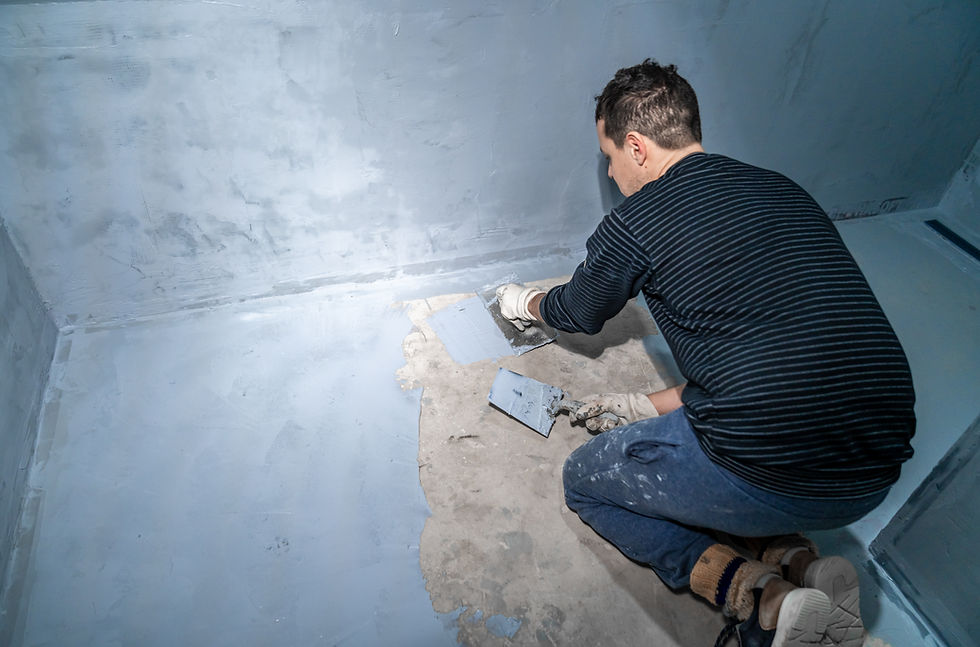7 Must-Know Tips for Maintaining Your Basement Waterproofing System
- Adam Basement

- 7h
- 4 min read
Water's Sneaky. Don’t Let It Win.

You know that feeling when it’s been pouring rain for hours, and you find yourself doing the basement peek? You slowly crack the door open and just pray you’re not about to step into a swamp.
I’ve been there. And so do a lot of my clients.
Hey, I’m Adam Basement—your local waterproofing specialist, basement rescuer, and guy who’s probably been in more crawl spaces than I care to count. And let me tell you this: even the best waterproofing system needs a little TLC to keep doing its job.
So today, we're diving into basement waterproofing maintenance. (See what I did there?) Because a little upkeep now saves you a whole lot of stress (and cash) later.
1. Schedule Seasonal Basement Waterproofing Maintenance/Inspections (Yes, Even When It Looks Fine)
Look, I know you’ve got better things to do than crawl around your basement every few months. But here's the thing: most water issues don’t start with dramatic floods. They start with tiny shifts, hairline cracks, or a sump pump that hums but doesn’t pump.
Spring and fall are prime times to check in. Why?
Spring = melting snow + heavy rain
Fall = prepping for winter freezes and future thaws
A simple seasonal check can spot problems early. And if you're not sure what to look for, no shame in calling your favorite local expert (that’d be Adam Basement, yes).
2. Clean Those Pumps and Drains (Yes, Regularly)
Your sump pump? It’s not magic. It’s a hard-working machine that needs a little love.
Over time, dirt, debris, and even lint from the air can gunk up the works. And that means:
Slow drainage
Overheating
Total failure during a big storm (which is when you need it most)
Every 3-6 months, give it a visual check. Clear any visible sludge. Pour some water into the pit, too, to test if it kicks on. If it groans or hesitates, well, it might be time for a deeper clean—or a professional checkup.
And the same goes for interior or exterior drainage lines. Leaves and mud can also block flow, even in the neatest yards.

3. Keep an Eye on Humidity Levels
You know that funky smell in basements? Yes, and that’s not just "basement smell." That’s mold auditioning for a permanent role.
Basement humidity should stay under 50%. And if you don’t have one already, grab a digital hygrometer. They’re cheap, accurate, and will save you guesswork.
If things are feeling tropical down there:
Check for slow leaks or seepage
Make sure vents or windows are working (and not letting in humid air)
High humidity = slow rot. And waterproofing systems can only do so much if the air itself is working against them.
4. Reseal When Needed (Don’t Just Set It and Forget It)
This one surprises people, but membranes and sealants don’t last forever. Especially in areas with big temp swings, shifting soil, or regular hydrostatic pressure (a fancy term for "wet ground pushing on your walls").
So how do you know it’s time to reseal?
You see efflorescence (that white, chalky stuff on walls)
Paint is bubbling or peeling
Cracks are showing up where things used to be smooth
Keep in mind that even the best membrane might start to fail after 7-10 years. A good local waterproofing pro (again, hi!) can check those weak points before they become real issues.
5. Watch for Subtle Signs of Wear
Here’s the deal: most basement issues sneak in sideways. Not with a bang, but a drip.
Keep an eye out for:
Slight discoloration on walls or floors
Soft spots under carpet or laminate
That unmistakable "damp cardboard" smell
A sump pump that sounds different than usual
These might seem like small annoyances, but they often point to a bigger underlying problem.
I always say: Your house talks to you. You just have to listen before it starts yelling.

6. Test Your Backup Systems (Because Power Outages Love Storms)
Most basement leaks happen during storms. And guess what else storms love to do? Knock out your power.
So if you’ve got a battery backup or water-powered sump system, test it. Make sure:
The battery is charged
It kicks in automatically
There’s no corrosion on terminals or wiring
A backup that fails when the main pump fails is a two-for-one disaster you do not want to deal with at 2 AM.
7. Build a Relationship with a Pro (Seriously, It’s Worth It)
Look, you don’t have to be best friends with your waterproofing contractor. But having someone you trust—who knows your system, your house, your neighborhood soil—that’s huge!
Every home is different. Some basements sit high and dry; others are water magnets. That's why having a local basement waterproofing expert on speed dial (someone like me, Adam Basement) makes maintenance easier, faster, and a whole lot less stressful.
Final Thoughts: Waterproofing Doesn’t End After Installation
Think of your waterproofing system like a car. You don’t drive it for 10 years without an oil change and expect it to run perfectly, right?
Basement Waterproofing Maintenance is no different. With just a few check-ins a year, you can avoid those massive repairs, protect your home’s value, and keep mold and mildew out of the picture.
Feel unsure? Don't know how to maintain basement waterproofing? That’s what I’m here for. Local, honest, experienced—and ready to help you stay dry, year-round.
Let’s Keep That Basement Dry, Together
Need help figuring out if your system’s due for a tune-up? Want a quick walkthrough of your sump pump maintenance or a moisture check after that last storm?
Give me a shout. I’m Adam Basement, your local basement waterproofing guy. No pushy sales talk, no fear-mongering. Just straightforward advice and real solutions that work for your home.
Reach out for a free inspection or maintenance consult today. Let’s keep the water outside, where it belongs.




Comments